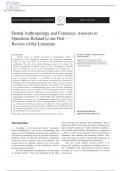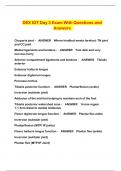DOI: 10.5937/bjdm2401027L
L SOCIETY
BALKAN JOURNAL OF DENTAL MEDICINE ISSN 2335-0245
CA
GI
LO
TO
STOMA
Dental Anthropology and Forensics: Answers to
Questions Related to our Past –
Review of the Literature
SUMMARY Evangelos Liappis1, Pelagia Karamani2,
Dental science is directly correlated to anthropology, which is Chrysi Papadeli3
attributed to teeth’s significant advantages and properties. Meanwhile, Department of Dentoalveolar Surgery,
justice is better and easier served due to the contribution of forensic Implantology and Oral Radiology, School of
odontology. The aim of the present literature review is to present the Dentistry, Aristotle University of Thessaloniki,
decisive contribution of dental science to the investigation of human Thessaloniki, Greece
species’ evolution, as well as to the demystification of criminal cases. A
thorough research has been conducted in scientific databases and scientific
textbooks related to our review. It is obvious that the assessment of gradual
modifications in human dentition as time passes by is indicative of human
species’ evolution. Nowadays, it is feasible to determine an excavated
skeleton’s identity and, as far as the ancient civilizations are concerned, to
investigate their intercultural relationships, their dietary customs and their
oral health’s status. With regard to forensics, the structure of cranial bones
is of great assistance in demystificating legal cases. Forensic odontology
provides forensic medical examiners with the opportunity to faster identify
deceased people and more effectively examine abused victims. Certainly,
radiographic techniques, such as periapical radiographs as well as modern
radiographic methodologies (CT, CBCT, MRI), offer additional diagnostic
information in forensics. So, methodologies introduced by dental science
have become a remarkable assist in anthropological researches, as well
as in forensics. Nevertheless, there can be noticed a limited application of
forensic odontology’s principles in Greece. This fact may be attributed to the
technological capabilities of our country’s forensic laboratories rather than
the Greek experts’ level of expertise. REVIEW PAPER (RP)
Key-words: Anthropology, Forensic Odontology, Human Species Evolution Balk J Dent Med, 2024;27-32
Introduction fossils deriving from Primates and Anthropoids2. This is
attributed to their mostly intact structure as time passes by,
According to the American Dental Association, due to enamel’s resistance2,3. Teeth’s laboratory analysis is
Dental Anthropology is the sector of anthropology that easier, faster and financially advantageous in comparison
focuses on the development, evolution and variability of to bones, as they decay and easier absorb environmental
teeth and the surrounding orofacial anatomical structures1. substances, thus affecting the laboratory results4. Also,
Dentistry seems to be directly correlated to archaeology. teeth can be used as a source of archaic DNA molecules to
It provides various academic and research benefits, thus isolate historically interesting genetic information5.
giving answers to questions related to the past based The aim of the present literature review is to
on the historical findings and the technology of three- present the significant contribution of dental science to
dimensional reconstruction1. the investigation and understanding of human species’
The teeth demonstrate a fundamental role with regard evolution, as well as to the demystification of criminal
to skeleton analyses. They are considered as the rifest justice cases.
, 28 Evangelos Liappis et al. Balk J Dent Med, Vol 28, 2024
Material and Methods means he has two incisors, one canine, two premolars
and three molars per oral quadrant6,8. Such observations
The present review of the literature is based on regarding groups of teeth inform us about the dietary
published scientific papers from databases PubMed and habits and social activity of civilizations of the past in
Google Scholar, as well as scientific textbooks. In order various environmental conditions9.
to accumulate papers for our review, we used a series of
key words and phrases: «forensic odontology», «forensic
Dental science in anthropology
dentistry», «human teeth evolution», «disaster victim It is widely accepted that multiple data of historical
identification» and «human bite marks». significance can be drawn by anthropological researches
on teeth. Specifically, scientists can calculate the age of
death and estimate the post-mortem period of time. As
far as children and adolescents are concerned, the most
Results accurate methodology to estimate their age of death is
the analysis of their teeth’s development and eruption in
We accepted thirty published papers, with conjunction with the examination of their symphyses8.
publication dates within the range 1980 – 2023, only eight On the contrary, when examining adult skeletons, medical
of which were published before 2014 and the rest 22 of examiners assess the teeth’s decaying and attrition,
them were published in the last decade (2014 – 2023). findings mainly observed on non-western skeletons dated
All publications chosen to be included as references have before the medieval period, without absolute credibility8.
been assessed and accepted by all authors of the review, Moreover, data can be gathered regarding the
after considering their abstracts, their publication dates, intercultural relationships of the past. The geographic
their references and their scientific credibility. distribution of a civilization is revealed by teeth’s number,
dimensions and morphology, the dental arch’s shape and
Regarding the scientific textbooks, all authors agreed
the geopolitical prevalence of those statistical sizes10.
to include textbooks published within the last twenty
Quantifiable variables, such as teeth’s mesiodistal and
years (2003 – 2023). In total, fifteen scientific books
buccolingual diameter, have shown that Neanderthals and
with information related to the scope of this particular
Homo erectus as well as Australian, North American and
review were gathered and examined. Three of them were
Sub-Saharan African natives possibly have the biggest
unanimously excluded due to insufficient justification. So,
crown size10,11. On the other hand, Scandinavian Sami,
finally, twelve textbooks were included in our literature
South African Bushmen and today’s East Asians, Indians
review, eight of which were published within the last
and Europeans are believed to have the smallest crown
decade (2014 – 2023).
size10. However, researches and their results based on
non-quantifiable variables, such as teeth’s anatomical
characteristics, seem to be of greater credibility. For
example, Carabelli’s cusp is found at almost 85% of
Discussion European’s molars, whereas it is rarely observed in
Human species evolution from dentistry’s Pacific Islanders12. Also, the existence of a three-rooted
mandibular premolar in the dentition of early Americans
perspective
divides them into Eskimos, Na-Dene and the so-called
Species during the Permian and Triassic period «other» Americans11. Last but not least, shovel-shaped
were characterized by conical non-differentiated teeth6. incisors were most frequently observed at regions of
Hundreds of years throughout human evolution were Eastern and Southeastern Asia and America9.
needed, until today’s mammals’ dentitions with milk Apart from these, anthropological researches can also
and permanent teeth and their anatomical variation6. conclude on past civilizations’ dietary habits and health
This gradual change pertains to humans as well, and the status by examining their skeletons’ teeth. Certainly,
multiple groups of teeth (incisors, canines, premolars, any pathological alterations or intentional interventions
molars) seem to be the result of the initially conical in the dentition reflect the identity, the customs, the diet
teeth’s fusion as time passed by6. This evolutionary fact is and the general health status of both the investigated
more than obvious nowadays if one notices the incisors’ individual and the whole population. Intentional tooth
mamelons and labial grooves, as well as the posterior extractions and posterior teeth’s occlusal grooves inform
teeth’s distinct cusps6. Moreover, during human species’ about an individual’s occupation and the social status13. In
evolution, there seems to be a gradual decrease in the total African, American and Asian populations, the shortening
number of teeth7. It is also worth noting that mammals are of teeth’s crowns was nothing but usual for cultural and
divided into groups based on the types of teeth per oral beautification reasons14. With regard to dietary habits,
quadrant. For instance, the today’s well-known Homo hunters and foragers, who consumed unprocessed leather,
sapiens follows the formula «2-1-2-3», which practically had disfigured occlusal and incisal edge anatomy10. On





